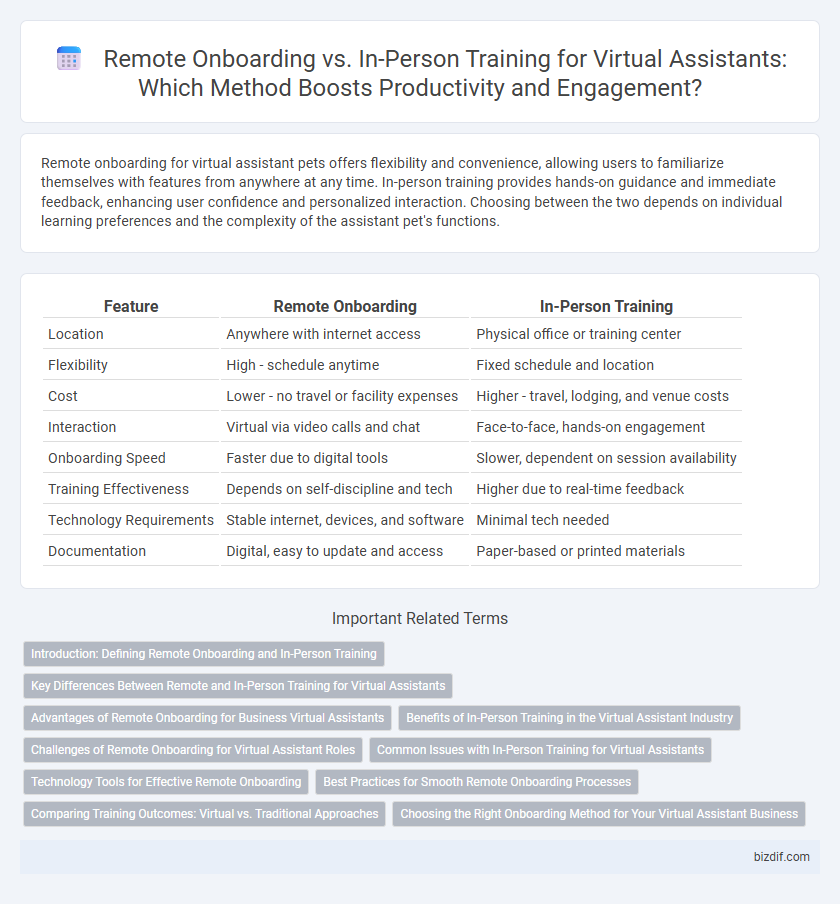Remote onboarding for virtual assistant pets offers flexibility and convenience, allowing users to familiarize themselves with features from anywhere at any time. In-person training provides hands-on guidance and immediate feedback, enhancing user confidence and personalized interaction. Choosing between the two depends on individual learning preferences and the complexity of the assistant pet's functions.
Table of Comparison
| Feature | Remote Onboarding | In-Person Training |
|---|---|---|
| Location | Anywhere with internet access | Physical office or training center |
| Flexibility | High - schedule anytime | Fixed schedule and location |
| Cost | Lower - no travel or facility expenses | Higher - travel, lodging, and venue costs |
| Interaction | Virtual via video calls and chat | Face-to-face, hands-on engagement |
| Onboarding Speed | Faster due to digital tools | Slower, dependent on session availability |
| Training Effectiveness | Depends on self-discipline and tech | Higher due to real-time feedback |
| Technology Requirements | Stable internet, devices, and software | Minimal tech needed |
| Documentation | Digital, easy to update and access | Paper-based or printed materials |
Introduction: Defining Remote Onboarding and In-Person Training
Remote onboarding involves integrating new employees through digital platforms, utilizing virtual tools like video conferencing, online training modules, and real-time collaboration software to facilitate a seamless introduction to company protocols. In-person training refers to traditional face-to-face orientation sessions where new hires engage directly with trainers and colleagues, allowing for immediate feedback and hands-on experience. Both methods serve to acclimate employees but differ significantly in delivery, interaction style, and resource utilization within workforce development.
Key Differences Between Remote and In-Person Training for Virtual Assistants
Remote onboarding for virtual assistants leverages digital platforms to deliver flexible, scalable training, allowing access to resources anytime and supporting diverse time zones. In-person training emphasizes direct interaction, immediate feedback, and hands-on experience, fostering stronger team dynamics and real-time problem-solving. Key differences include communication methods, accessibility of materials, and adaptability to individual learning preferences, impacting efficiency and engagement in the onboarding process.
Advantages of Remote Onboarding for Business Virtual Assistants
Remote onboarding for business virtual assistants offers significant advantages including increased flexibility, reduced costs, and access to a broader talent pool. It enables seamless integration into company systems through digital tools and platforms, enhancing productivity from day one. Scalability and time efficiency are further benefits, allowing businesses to onboard multiple assistants concurrently without geographic constraints.
Benefits of In-Person Training in the Virtual Assistant Industry
In-person training in the virtual assistant industry enhances hands-on learning, allowing trainees to immediately ask questions and receive real-time feedback, which improves skill retention. This method fosters stronger interpersonal relationships and team cohesion, essential for collaborative virtual work environments. Additionally, face-to-face interaction helps trainers better assess trainee engagement and comprehension, leading to more personalized and effective development.
Challenges of Remote Onboarding for Virtual Assistant Roles
Remote onboarding for virtual assistant roles faces challenges such as limited hands-on training and difficulties in building team rapport through virtual communication. Inadequate access to real-time feedback and technical issues can hinder skill development and performance assessment. Ensuring consistent engagement and clear communication protocols is critical to overcoming these obstacles.
Common Issues with In-Person Training for Virtual Assistants
In-person training for virtual assistants often encounters challenges such as limited flexibility in scheduling, higher costs due to travel and venue expenses, and reduced accessibility for remote employees. This method can also lead to inconsistent knowledge retention because of one-size-fits-all approaches that fail to address individual learning paces. Furthermore, in-person sessions may disrupt productivity by requiring physical presence, which is less efficient compared to remote onboarding solutions optimized for virtual work environments.
Technology Tools for Effective Remote Onboarding
Technology tools such as video conferencing platforms, collaborative project management software, and interactive learning modules play a crucial role in effective remote onboarding by ensuring real-time communication and seamless access to training resources. Virtual assistants can automate scheduling, track progress, and provide instant support, enhancing employee engagement and reducing onboarding time. Leveraging AI-driven analytics helps tailor training materials to individual learning styles, maximizing knowledge retention in remote environments.
Best Practices for Smooth Remote Onboarding Processes
Effective remote onboarding processes leverage interactive virtual platforms to simulate hands-on experiences and foster real-time engagement. Clear communication protocols and structured schedules enhance new hires' understanding and integration into company culture. Utilizing digital collaboration tools ensures continuous support and seamless knowledge transfer during remote training sessions.
Comparing Training Outcomes: Virtual vs. Traditional Approaches
Remote onboarding leverages digital tools to provide flexible, accessible training, resulting in higher employee engagement and faster skill acquisition compared to in-person training. Traditional methods offer hands-on experience and immediate feedback, benefiting learners who thrive in direct interaction environments. Studies reveal that virtual training often leads to equal or improved retention rates and cost-effectiveness, while in-person sessions excel in fostering team cohesion and practical application.
Choosing the Right Onboarding Method for Your Virtual Assistant Business
Selecting the right onboarding method significantly impacts the efficiency and integration of your virtual assistant team. Remote onboarding offers flexibility and access to global talent, while in-person training fosters direct communication and stronger team cohesion. Assess your business's scale, budget, and technological capabilities to determine which approach maximizes productivity and aligns with your company culture.
Remote Onboarding vs In-Person Training Infographic

 bizdif.com
bizdif.com